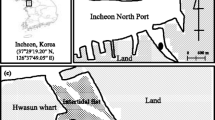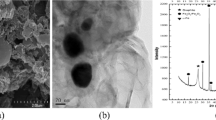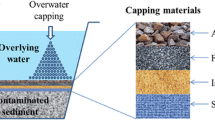Abstract
Heavy metal–contaminated sediment is a common environmental problem. In situ stabilization is an effective and low-cost method to remediate heavy metal–contaminated sediment. In this study, a red mud-based low-cost composite (RMM) was used to stabilize heavy metal–contaminated sediment. RMM was mixed with heavy metal–contaminated sediment at the doses of 0%, 1%, 3% and 5%. The CaCl2-extractable, DTPA-extractable, leachability (TCLP) and heavy metal fractions were analysed to evaluate the stabilization efficiency of RMM for heavy metals. The selected properties and microbial activities of the sediment were analysed to verify the safety of RMM to sediment. The results showed that RMM reduced the DTPA-, CaCl2- and TCLP-extractable heavy metals in sediment. At an RMM dose of 5%, DTPA-, CaCl2- and TCLP- extractable heavy metals were reduced by 7.60%, 72.34% and 69.24% for Pb; 18.20%, 76.7% and 23.57% for Cd; 32.7%, 96.50% and 49.64% for Zn; and 35.0%, 61.20% and 55.27% for Ni, respectively. TCLP- and DTPA-extractable Cu was reduced by 71.15% and 12.90%, respectively. In contrast, CaCl2-extractable Cu increased obviously after the application of RMM. RMM reduced the acid-soluble fraction of Zn by 6.99% and increased the residual fraction of Ni by 4.28%. However, the influence of RMM on the fractions of Pb, Cd and Cu was nonsignificant. In addition, the application of RMM increased the pH values of the sediment, and the microbial activity in the sediment was also obviously enhanced. These results indicated that RMM has great potential in the remediation of heavy metal–contaminated sediment.






Similar content being viewed by others
References
Adeoye GO, Agboola AA (1985) Critical levels for soil pH, available P, K, Zn and Mn and maize ear-leaf content of P, Cu and Mn in sedimentary soils of South-Western Nigeria. Fertil Res 6:65–71
Bhatnagar A, Vilar VJ, Botelho CM, Boaventura RA (2011) A review of the use of red mud as adsorbent for the removal of toxic pollutants from water and wastewater. Environ Technol 32:231–249
Bolan N, Kunhikrishnan A, Thangarajan R, Kumpiene J, Park J, Makino T, Kirkham MB, Scheckel K (2014) Remediation of heavy metal(loid)s contaminated soils--to mobilize or to immobilize? J Hazard Mater 266:141–166
Chen WF, Zhang J, Zhang X, Wang W, Li Y (2016) Investigation of heavy metal (Cu, Pb, Cd, and Cr) stabilization in river sediment by nano-zero-valent iron/activated carbon composite. Environ Sci Pollut Res Int 23:1460–1470
Fang Y, Li J, Han P, Han Q, Li M (2018) Less toxic zinc(II), diorganotin(IV), gallium(III) and cadmium(II) complexes derived from 2-benzoylpyridine N,N-dimethylthiosemicarbazone: synthesis, crystal structures, cytotoxicity and investigations of mechanisms of action. Toxicol Res-UK 7:987–993
Geng H, Wang L (2019) Cadmium: toxic effects on placental and embryonic development. Environ Toxicol Phar 67:102–107
Huang D, Liu L, Zeng G, Xu P, Huang C, Deng L, Wang R, Wan J (2017) The effects of rice straw biochar on indigenous microbial community and enzymes activity in heavy metal-contaminated sediment. Chemosphere 174:545–553
Lee S, Kim E, Hyun S, Kim J (2009) Metal availability in heavy metal-contaminated open burning and open detonation soil: assessment using soil enzymes, earthworms, and chemical extractions. J Hazard Mater 170:382–388
Li L, Hou M, Cao L, Xia Y, Shen Z, Hu Z (2018) Glutathione S-transferases modulate Cu tolerance in Oryza sativa. Environ Exp Bot 155:313–320
Liu K, Bai L, Shi Y, Wei Z, Spinney R, Göktaş R, Dionysiou D, Xiao R, (2020) Simultaneous disinfection of E. faecalis and degradation of carbamazepine by sulfate radicals: an experimental and modelling study. Environ Pollut 263:114558
Li XH, Zhu WG, Meng GJ, Guo RC, Wang YL (2020) Phytoremediation of alkaline soils co-contaminated with cadmium and tetracycline antibiotics using the ornamental hyperaccumulators Mirabilis jalapa L. and Tagetes patula L. Environ Sci Pollut Res 27:14175–14183
Liang Y, Cao X, Zhao L, Arellano E (2014) Biochar- and phosphate-induced immobilization of heavy metals in contaminated soil and water: implication on simultaneous remediation of contaminated soil and groundwater. Environ Sci Pollut Res Int 21:4665–4674
Liu SJ, Liu YG, Tan XF, Zeng GM, Zhou YH, Liu SB, Yin ZH, Jiang LH, Li MF, Wen J (2018) The effect of several activated biochars on Cd immobilization and microbial community composition during in-situ remediation of heavy metal contaminated sediment. Chemosphere 208:655–664
Mustafa G, Singh B, Kookana RS (2004) Cadmium adsorption and desorption behaviour on goethite at low equilibrium concentrations: effects of pH and index cations. Chemosphere 57:1325–1333
Oprckal P, Mladenovic A, Zupancic N, Scancar J, Milacic R, Serjun V (2020) Remediation of contaminated soil by red mud and paper ash. J Clean Prod 256:120440
Peng JF, Song YH, Yuan P, Cui XY, Qiu GL (2009) The remediation of heavy metals contaminated sediment. J Hazard Mater 161:633–640
Shen Z, Hou D, Zhao B, Xu W, Ok YS, Bolan NS, Alessi DS (2018) Stability of heavy metals in soil washing residue with and without biochar addition under accelerated ageing. Sci Total Environ 619-620:185–193
Shin W, Kim YK (2015) Stabilization of heavy metal contaminated marine sediments with red mud and apatite composite. J Soils Sediments 16:726–735
Shin WS, Kang K, Park SJ, Um BH, Kim YK (2012) Application of red mud and oyster shell for the stabilization of heavy metals (Pb, Zn and Cu) in marine. Contam Sediment 34:751–756
Singh P, Wang W, Shrivastava A (2018) Cadmium-mediated morphological, biochemical and physiological tuning in three different Anabaena species. Aquat Toxicol 202:36–45
Tomasevic DD, Dalmacija MB, Prica M, Dalmacija BD, Kerkez DV, Becelic-Tomin MR, Roncevic SD (2013) Use of fly ash for remediation of metals polluted sediment--green remediation. Chemosphere 92:1490–1497
Wang Y, Fang Y, Zhao M, Li M, Ji Y, Han Q (2017) Cu(II), Ga(III) and In(III) Complexes of 2-Acetylpyridine N(4)-phenylthiosemicarbazone: synthesis, spectral characterization and biological activities. Med Chem Comm 8:2125–2132
Wang Y, Li F, Song J, Xiao R, Luo L, Yang Z, Chai L (2018) Stabilization of cd-, Pb-, Cu- and Zn-contaminated calcareous agricultural soil using red mud: a field experiment. Environ Geochem Health 40:2143–2153
Wang Y, Ma XY, Wang JN, Cheng SS, Ren Q, Zhan W, Wang Y (2019) Effects of mercapto-functionalized nanosilica on Cd stabilization and uptake by wheat seedling (Triticum aestivum L.) in an agricultural soil. Bull Environ Contam Toxicol 103:860–864
Wang Y, Liu Y, Zhan W, Zheng KX, Lian MM, Zhang CS, Ruan XL, Li T (2020a) Long-term stabilization of Cd in agricultural soil using mercapto functionalized nano-silica (MPTS/nano-silica): a three-year field study. Ecotoxicol Environ Saf 197:110600
Wang Y, Liu Y, Zhan W, Zheng K, Wang J, Zhang C, Chen R (2020b) Stabilization of heavy metal-contaminated soils by biochar: challenges and recommendations. Sci Total Environ 30:139060
Wei Z, Li W, Zhao D, Seo Y, Spinney R, Dionysiou D, Wang Y, Zeng W, Xiao R (2019) Electrophilicity index as a critical indicator for the biodegradation of the pharmaceuticals in aerobic activated sludge processes. Water Res 160:10–17
Wen J, Yi Y, Zeng G (2016) Effects of modified zeolite on the removal and stabilization of heavy metals in contaminated lake sediment using BCR sequential extraction. J Environ Manag 178:63–69
Wu C, Luo Y, Zhang L (2010) Variability of copper availability in paddy fields in relation to selected soil properties in southeast China. Geoderma 156:200–206
Xiao R, Bai L, Liu K, Shi Y, Minakata D, Huang C, Spinney R, Seth R, Dionysiou D, Wei Z, Sun P (2020a) Elucidating sulfate radical-mediated disinfection profiles and mechanisms of Escherichia coli and Enterococcus faecalis in municipal wastewater. Water Res 173:115552
Xiao R, He L, Luo Z, Spinney R, Wei Z, Dionysiou D, Zhao F (2020b) An experimental and theoretical study on the degradation of clonidine by hydroxyl and sulfate radicals. Sci Total Environ 710:136333
Xiao R, Ma J, Luo Z, Zeng W, Wei Z, Spinney R, Hu W, Dionysiou D (2020c) Experimental and theoretical insight into hydroxyl and sulfate radicals-mediated degradation of carbamazepine. Environ Pollut 257:113498
Xue W, Huang D, Zeng G, Wan J, Zhang C, Xu R, Cheng M, Deng R (2018) Nanoscale zero-valent iron coated with rhamnolipid as an effective stabilizer for immobilization of Cd and Pb in river sediments. J Hazard Mater 341:381–389
Zang F, Wang S, Nan Z, Ma J, Li Y, Zhang Q, Chen Y (2017) Immobilization of Cu, Zn, Cd and Pb in mine drainage stream sediment using Chinese loess. Chemosphere 181:83–91
Zhang C, Shan B, Zhu Y, Tang W (2018) Remediation effectiveness of Phyllostachys pubescens biochar in reducing the bioavailability and bioaccumulation of metals in sediments. Environ Pollut 242:1768–1776
Zhou R, Liu X, Luo L, Zhou Y, Wei J, Chen A, Tang L, Wu H, Deng Y, Zhang F (2017) Remediation of Cu, Pb, Zn and Cd-contaminated agricultural soil using a combined red mud and compost amendment. Int Biodeterior Biodegradation 118:73–81
Funding
This work was supported by a grant from the National Natural Science Foundation of China (51704093), Open Funding Project of National Key Laboratory of Human Factors Engineering (SYFD180051810K and 614222207041813), and First-class Disciplines Innovation Team Training Projects in Henan University (2019YLZDYJ12, 2018YLTD16).
Author information
Authors and Affiliations
Corresponding author
Additional information
Responsible Editor: Philippe Garrigues
Publisher’s note
Springer Nature remains neutral with regard to jurisdictional claims in published maps and institutional affiliations.
Electronic supplementary material
ESM 1
(DOCX 18 kb)
Rights and permissions
About this article
Cite this article
Ma, X., Ren, Q., Zhan, W. et al. Effectively reducing the bioavailability and leachability of heavy metals in sediment and improving sediment properties with a low-cost composite. Environ Sci Pollut Res 27, 45581–45590 (2020). https://doi.org/10.1007/s11356-020-10343-9
Received:
Accepted:
Published:
Issue Date:
DOI: https://doi.org/10.1007/s11356-020-10343-9




